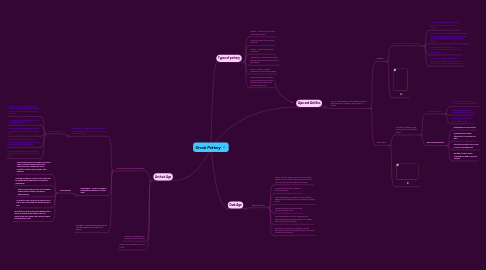
1. Archaic Age
1.1. Styles of decoration on pottery
1.1.1. Black figure - figures on the pot where all details were scratched in, leading to simple designs
1.1.1.1. disadvantages
1.1.1.1.1. an artist could not put to much detail in as the design would crack if two or more lines were to close together
1.1.1.1.2. one would have to slowly chisel in tiny details slowly
1.1.1.1.3. lines could not overlap realistically leading to a very two dimensional look
1.1.1.1.4. control over a chisel is hard to master leading to the use of curved lines being very uncommon
1.1.1.1.5. nearly impossible to show emotion because fine details were so hard to create
1.1.2. Red figure - a figure made by painting the design on (later age)
1.1.2.1. advantages
1.1.2.1.1. curves were easier to make as control over a brush is much easier than chiseling lines, leading to more realistic people, expressions, and animals
1.1.2.1.2. varying shades of red to rust brown led to shading and therefore a feeling of dimension
1.1.2.1.3. one can overlap lines so as to make a scene more realistic and three demensional
1.1.2.1.4. an artist could control the texture of a piece by controlling the thickness of a line
1.1.2.1.5. an artist can put much more detail into a piece as in the black figure style to many lines near each other would cause the piece to crack
1.1.3. Bilingual - incorporates both Black and Red figure styles into one piece
1.2. Pottery dominated by Athenians due to trade
1.3. overcome the idea of Horror Vacui
2. Dark Age
2.1. characteristics
2.1.1. Horror Vacui - the need to fill every little space for fear that blank space will let evil into this world from the divine realm
2.1.2. a rigid division into a rational balanced order
2.1.3. use of geometric shapes - (circles do not show up as primitive tools are hard to create well)
2.1.4. three horizontal lines separate sections of the vase
2.1.5. most important scene is between the handles where the vase swells out, makes the scene stand out and
2.1.6. people and animals are made of crude geometric parts, reflecting the general lack of skills of the artist
3. Types of pottery
3.1. Hydria - used to pour water and other liquids
3.2. Lekythos used to pour and store oil
3.3. Krater - used to mix water and wine
3.4. Oenochoe - used as a pouring jug for water and wine mixed in the Krater
3.5. Kylix - used as a large drinking cup for diluted wine
3.6. Amphora used for storign and pouring liquids or dry goods (larger ones used for grave markers)
4. Ajax and Achilles
4.1. scene: shows Ajax and Achilles playing a game of dice (chance = war) prior to battle
4.1.1. Exekias
4.1.1.1. Black figure (see Archaic Age)
4.1.1.1.1. very intricate details carved into the piece (uncommon for this style)
4.1.1.1.2. Achilles (left) is wearing a helmet making him seem bigger than Ajax, showing that the artist thought Achilles the better warrior
4.1.1.1.3. shields and handles are like curtains, framing the scene much like a stage
4.1.1.1.4. all objects (shields, position of characters, spears, etc.) point to the center of the piece, the game of dice
4.1.1.2. .
4.1.2. Andokides
4.1.2.1. Bilingual (both red and black figures on the the vase)
4.1.2.1.1. Black figure side
4.1.2.1.2. Red figure portion
4.1.2.2. .
